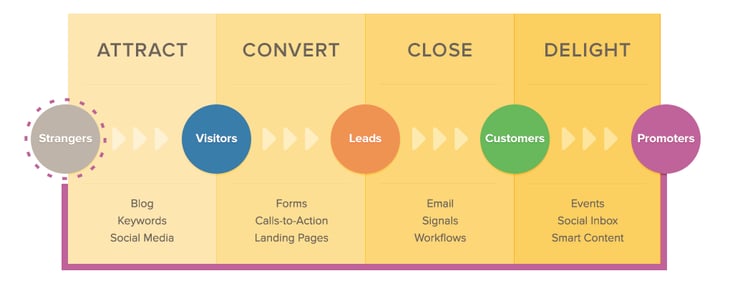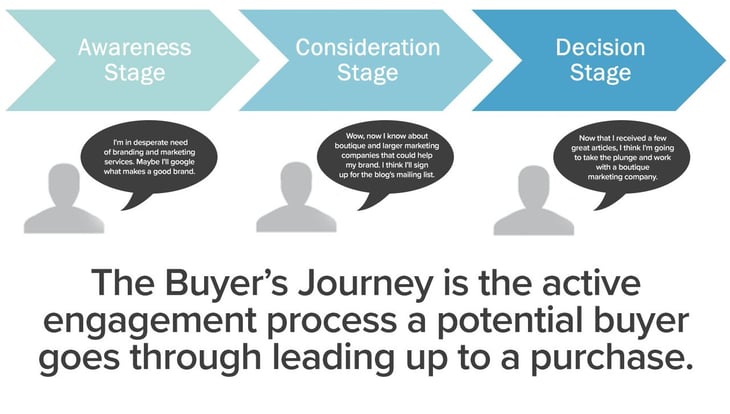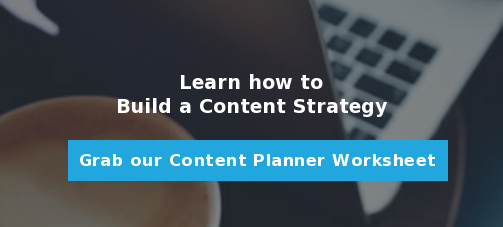Do you market a successful brand that is making significant strides, but the website is receiving zero traffic?... and you cannot help but think "what are we doing wrong?!"
It's time to stop the questioning and be introduced to the game changer: Inbound Marketing.
Inbound Marketing is a way of structuring your marketing to focus on content, SEO, and an effective sales funnel to drastically increase “leads” for business marketers.
We have consistently seen credible results from implementing the methodology across a variety of business sectors.
With such successful results, it would be almost selfish to not share more! The following is an overview of the power of Inbound Marketing.
What is Inbound Marketing?
- It is a proven methodology to turn strangers into customers and promoters of your brand.
- It is strategic content marketing.
- It is marketing that draws people in while creating lifetime customers by building lasting relationships and content in instead of focusing on one-off, interruption advertising strategies.
To wrap your head around Inbound, first consider the less effective strategy of Interruption Marketing. It is likely that many of you are familiar with the Interruption Marketing tactics like pop-up ads, spam emails, print mail that is instantly recycled, lack of customer permission, and ultimately the intent to interrupt your focus to bring attention to the brand. To be fair, Interruption Marketing used to be an effective business strategy, but those days are gone.
Inbound Marketing on the other hand is a user-friendly, permission-centric, content-based marketing methodology that focuses on developing relationships with people before, during, and after they become customers. This is done by supplying well-timed and useful information the potential client is searching for.
Now with the basic principles of Inbound covered, a high level, condensed overview that demonstrates the strategy’s revolutionizing potential for your digital marketing will be explored. Today, we will focus on two of the main Inbound points.
The Inbound Methodology

The goal of the Inbound Methodology is to reach potential customers at all designated “lifecycle stages” by attracting, converting, closing, and ultimately delighting each customer by using appropriate content at the right times to achieve the best marketing value for each dollar.
An example of how a customer might interact with a PR company:
1. Attract
Through initial exposure to the brand through a blog or social media.
2. Convert
By being engaged with a call-to-action to download a free tutorial or class, added to a blog email list, or sent engaging content that requires a sign up to access. The convert stage most commonly uses an email capture of sorts to determine a successful "conversion".
3. Close
Close is the stage in which a sale occurs. In our example, an email subscriber may be sent a 25% discount on their custom biography if they choose to purchase within that same week or a free PR consultation.
4. Delight
Through continued email and social marketing. The idea here is to keep your customers coming back AND having them spread the word about your business. Perhaps our PR company releases a blog featuring some of their clients and keeps them update on new services etc.
Or here’s an example of what a customer’s lifecycle of a Personal Stylist might look like:
1. Attract
Through initial exposure via the company blog or social media. Maybe this customer saw their friend like an "awareness stage" post on "5 Style Tips to Avoid Looking Older than You Are".
2. Convert
by being engaged with a call-to-action to download a free app, added to the email list, or by filling out a form to download our stylist's "15 Ways to Wear Scarves" PDF.
3. Close
by being sent a discount to purchase clothing pieces or new trendy items.
4. Delight
By offering group discounts to friends, referral credits, and free delivery of additional style materials.
The Buyer's Journey
The sister framework to our inbound methodology funnel is "The Buyer's Journey". Attract, convert, close, and delight cover how someone thinks about inbound from the marketer's perspective, and the "Buyer's Journey" covers the thought process from the client's perspective. It's how a client thinks through a purchasing decision and is useful for tailoring your content to their "objection" questions. Check out this graphic:

So, this gets a bit tricky, but essentially this three-stage process occurs within the Attract and Convert stages outlined above. You'll notice that the decision stage ends with the client asking how they can buy or how they can "close." Make sense? It's up to us to make sure we're giving the potential customer the most appropriate next step according to their buyer's journey stage. If someone barely knows your brand, you don't always want to hammer them with a decision stage content offer that tries to get them to purchase. Instead, you would send them a useful awareness piece that educates them on their problem or need.
Check out these examples for more clarification: Again, two different examples will be explored.
For a potential customer of a PR company:
Awareness Stage:
A brand knows their press coverage needs to be expanded and is considering professional options. They are unsure if they should outsource the work, so they begin to read a variety of materials on how to better improve press coverage.
Consideration Stage:
The musician decides that hiring a PR firm is the right choice after reading blogs and talking to fellow professionals. They seek out materials on what to look for in a strong PR firm and how to choose the right one.
Decision Stage:
The musician begins comparing different PR companies by compiling a list based on recommendations and websites that caught their attention.
For a potential customer of a Stylist:
Awareness Stage:
A potential customer hears a friend talking about the Stylist on Social Media.
Consideration Stage:
The potential customer decides to follow the Stylist on Social Media or an email list to see what this is all about.
Decision Stage:
The potential customer is blown away by the personality and creativity of the Stylist and decides to see for themselves and books a consultation.
-----------
Now, you want to place specific content that relates to that potential customer within their current stage of the Buyer's Journey. It’s all about timing.
For example, in the consideration stage for the potential PR company client, you could have blogs analyzing the aspects and offers that set a strong PR company apart from the competition. Here, you could have an “Overview of Our Services” download available for the decision stage placed nicely at the end of the blog. If they download the overview, you could automatically enroll them in an email automation workflow that offers a free consultation. Effective, to say the least.
To Conclude
The goal is to produce a variety of content for buyers at all stages. Part of this is simply consistency, but the other more important piece is knowing where most of your buyers fall in their journey.
To do so, it must be understood:
- which customers engage with you the most
- which customers have purchased in the past
- what routes, segments, or content give you the best conversion from "stranger" to "customer" to "promoter"
For example, if you had an exclusive item with a limited supply, would it be more efficient to reach out to your entire customer base or just the segments you know are already interested?
With this, an important attribute of Inbound is to make customers feel more valued at each stage. Your brand is a story — let people take part in it.
Finally, keep in mind that content creation, publishing and analytics tools all work together like a well-oiled machine. This allows you to focus on publishing the right content in the right place at the right time.
Here are a few tools to help you get started with Inbound Marketing
Buffer, Hootsuite, or Followerwonk - Track your content on Social Networks. Use this along with LeadIn to see you best referral of visitors.
Canva: Super easy and professional graphics making webapp that you can use on your desktop or your phone.
Cloud App: Let's you share files with team members digitally.
Dropbox: Its ease of use, time-test security, and multi-tiered "storage-space" options make it attractive to anyone from college students to Fortune 500 companies.
Everhour: Time tracking software that integrates seamlessly into your browser and/or project management software.
Evernote: Create notes, reminders, and to-do lists and keep them all in one, easy to search place.
Facebook Audience Pixels - Gather information about your website visitors and optimize Facebook’s algorithms for effective ad campaigns.
Google Webmaster Tools: Use these tools to submit sitemaps and cater your site's content to Google crawlers for SEO best practices.
Grammarly: Extension that proofreads across your entire browser.
Hubspot: A wide array of marketing and sales software programs that help automate and improve the efficiency of almost any marketing and sales effort.
LeadIn - Track how users interact on your site.
Mailchimp - Email marketing software.
Pexels: A CC0 (a.k.a. completely free) stock photo library.
Self Control: Allows you to block your own access to specific websites or mail servers for a certain amount of time.
SumAll - High level fan trends.
Slack: new generation AIM for business that integrates with Google Docs/Drive, allows you to set auto-responders/auto-reminders, quickly share files, and create a one-on-one or team chats.
Shopify: an ecommerce software that has everything you need to sell online, on social media, or in person.
Squarespace: Website hosting and development platform that makes it super easy to set up a well designed, hard working website. No coding required.
Stripe: Cheap service that allows you to process financial transactions through a digital store. Pair this with WooCommerce for a digital store.
Uberconference: Online conferencing tool that allows you to record your conferences, and includes a chat feature, file sharing feature, and a screen-sharing feature.
Woocommerce: Create products, set prices, add coupons, etc.. Does not include a payment option though! You have to integrate with Stripe or another payment service.
Wordpress: Highly customizable CMS for those of us who really enjoy development and design.
Ready for more? Check out part 2 and part 3 of [The Inbound Method] series!



